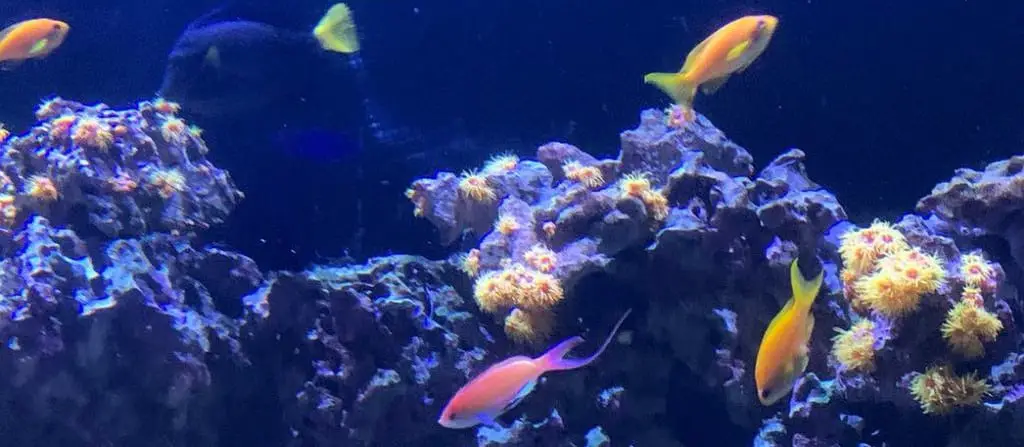Reef Tank Salinity Level – What’s Ideal?
One of the most attractive types of aquariums, and one that is sure to appeal to hobbyists everywhere, is the reef tank. Inside this relatively small glass box, you can capture and create your own little part of one the Earth’s finest creations; the coral reef.
The color and vibrancy of these tanks is simply unrivaled, but this doesn’t happen by magic. Creating an artificial ‘slice of paradise’ takes a lot of forethought, elbow grease, and of course some solid research.
For your reef tank to really reach its full potential you need to get all the variables right. This means using the proper filtration system, matching the inhabitants, and getting the pH and hardness right.
One thing some people slip up on is getting the reef tank salinity level correct. This is absolutely essential to ensure your saltwater fish live long and happy lives in your carefully crafted tank.
Table of Contents
What is a Reef Tank?

Before you set about getting the water chemistry of your tank right, you need to know exactly what a reef tank is. Very simply, a reef tank tries to recreate a coral reef ecosystem, much like the glorious Great Barrier Reef off the coast of Australia.
Of course, this is a saltwater environment filled with tropical creatures, living coral and bedrock. In a tank it is important to choose species that will coexist peacefully, since you cannot recreate the natural predator prey relationship in such a confined space.
In a reef tank you don’t just have to look after the nippy fish, you also need to look out for the living coral and make sure the conditions allow it to thrive as well. Some corals may be more demanding than others, requiring high levels of lighting or specific water chemistry, so it important to put as much thought into the coral selection as the fish selection.
What is Salinity Level?
Salinity refers to the level of dissolved salt in the water. Of course, we all know that the seawater is salty, but there is actually an exact science to determine how much salt is a good balance to allow your fish to thrive.
Salt that you mix into water to place in your tank dissolves in the water, meaning it disappears to the naked eye. But it’s definitely still there!
How to Measure Salinity Level?
To know whether your tank has the right salinity level, you must first have a reliable and accurate method of measuring the salinity of that tank.
Luckily, there are a number of easy to use methods available for the enthusiastic amateur. Salinity can be measured in a number of different ways.
Refractometers
For example, it is often customary to record the salinity in units of ppt, which stands for parts per thousand This refers to how many particles of salt are in your tank for every million particles of water.
Fortunately, you’re not required to count to thousands, the actual methods are far less labor intensive.
For example, you can purchase refractometers that are based on the conductivity of water, and will return you an accurate reading of the salinity in ppt.
[amazon box=”B018LRO1SU”]
Hydrometers
Alternatively, you could use a hydrometer to measure the specific gravity of your tank water. This is actually a far more popular method among reef tank owners.
See, when you change the salinity of your tank water, the density of the liquid changes. Add more salt and you will increase the specific gravity of the water, which can easily read off a hydrometer.
[amazon box=”B07FXV8KZ3″]
You can use either method to measure the salinity in your tank, and the results are completely interchangeable.
What is the Ideal Reef Tank Salinity Level?
This is the key question for all aspiring reef tank owners. In general, the optimum salinity levels will be different for each specific type of saltwater fish or coral that inhabits your tank, so you should look up their specific requirements before committing to a level.
However, most tank owners like to mimic the salinity of seawater as closely as possible, since this is reflective of their native environments, which they have evolved to thrive in over thousands of years.
For that reason, the ideal salinity level is thought to be 1.024-1.026 (in terms of specific gravity). If you are using an refractometer, you should try and keep the salinity levels around 35 ppt.
Salinity levels below this may be detrimental to the overall ecosystem, while levels greatly in excess are also likely to poison your fish.
The hardiness of corals, just like aquarium fish, varies greatly from species to species. Many types of hardy coral will survive in waters with specific gravity (SG) as low as 1.020, while others will turn bleached or brown very quickly if the salinity level falls below 1.024.
If this is your first time keeping a reef tank it is highly advised to get corals that are tolerant of a wide range of pH and salinity levels.
Don’t Change Salinity Levels Too Quickly
One thing that is important to remember is to make any changes to salt levels gradually over an extended period of time. Rapid changes to the salinity could be a great shock to the ecosystem and could cause distress in either your fish or corals.
Instead, if an increase or decrease in salinity is needed, you should make up the replacement reef tank water in a separate bucket, and exchange it for a small portion off the existing water. Repeat this over a few weeks until the desired level is reached.
Conclusion
Reef tanks can be a gorgeous sight and bring a lot of joy to their proud owners. However, you must ensure that you know how to care for all inhabitants of the ecosystem, including the lively fish and the not so lively coral.
This means knowing the correct chemical levels (e.g. ammonia, nitrate, phosphate levels etc.), the right temperatures and the right reef tank salinity level.
This is crucial to giving your fish a long, happy and most importantly healthy life, which reflects their conditions in the wild.




